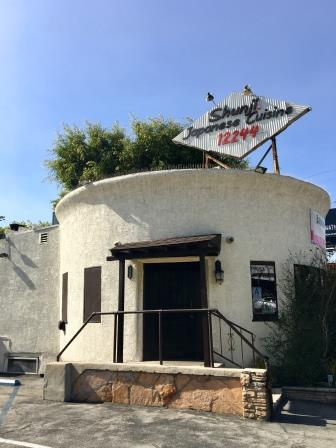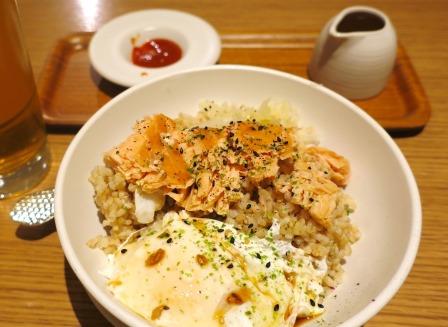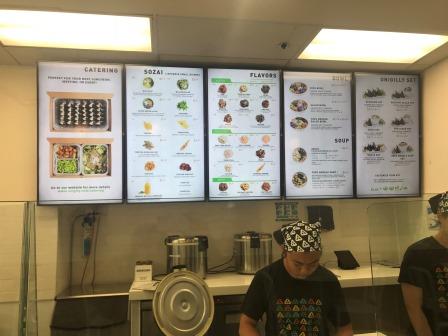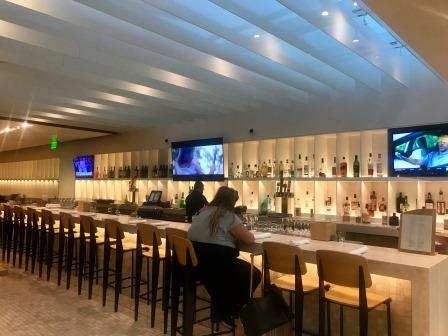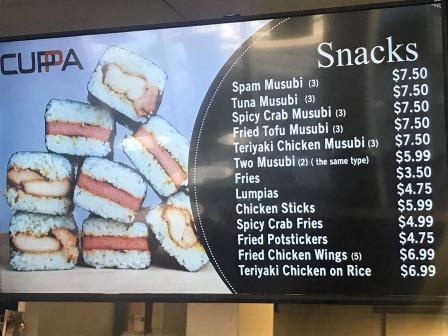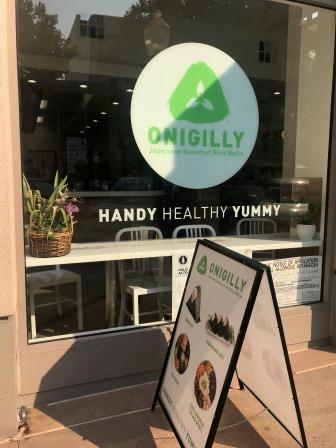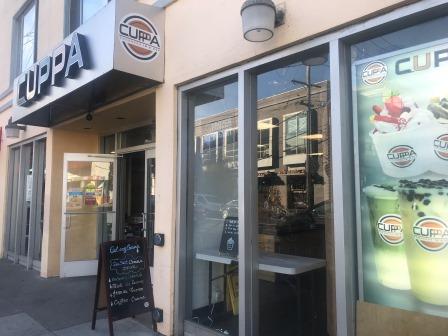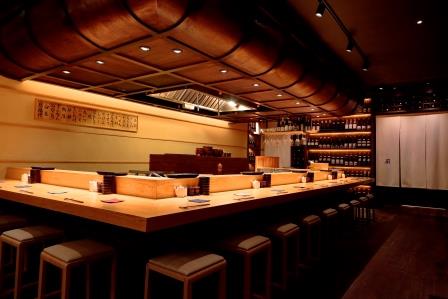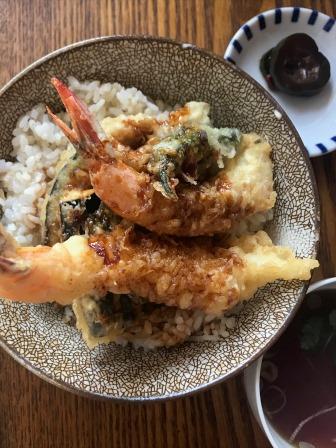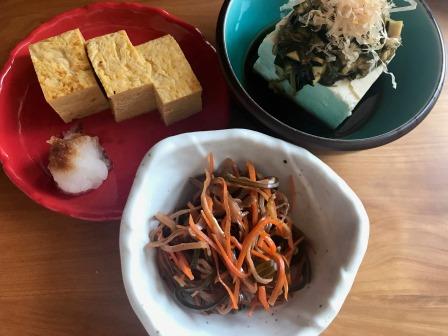The seafood and seasonal food ingredients come directly from Tsukiji Market. A popular restaurant specializing in sushi,
By Keiko Fukuda
On Pico Boulevard in West Los Angeles, near where the 405 and 10 freeways merge, stands “Japanese Cuisine Shunji”. When first completed in 1931, this roundish uniquely- shaped building was a chili bowl specialty restaurant, and before Shunji, it was a barbecue restaurant. Once you step into the building, a stylish brown-toned space opens up. Among the chic interior decorations, a large Japanese antique dresser which stands between the entrance and the sushi bar which dividing the two spaces, particularly attracts your attention.
“It is a vintage dresser from about 120 years ago,” says Shunji Nakao, the owner/chef. Not only does he have excellent taste in choosing furniture, he also designed the interior space by drawing his own image of it to remodel the place to the present style. The space near the ceiling is covered with dozens of articles published in the Los Angeles Times and LA Weekly, in which the restaurant was featured.
The food served here is sushi made with Tsukiji-direct ingredients, and seasonal cuisine in which plentiful seasonal ingredients are used. Shunji shows his particularity, especially in sushi and sashimi. “In the 1980’s, Japanese cuisine in the US was not well-established yet. Raw fish was not well accepted either.
People didn’t know the difference between sashimi and sushi. I used to wonder a lot about what to do to have Americans eat sashimi. I felt that I needed to keep educating customers who don’t know much about sushi, on the fact that sushi is more than salmon, spicy tuna, and Hamachi. Thankfully, many customers now have become able to eat various kinds of fish. Some of our regular customers have traveled to Japan, and visited well-known sushi restaurants,” says Shunji.
One such customer was Johnathan Gold, a food critic who was one of the admirers of Shunji’s sushi, who passed away recently.
Shunji came to live in the US in 1984. He worked at Osho restaurant on Third Street with Nobuyuki Matsuhisa (Nobu) and Tetsuya Nakao, his brother. In 1987, he followed Nobu when Nobu opened Matsuhisa in Beverly Hills. In 1991, he opened Asanebo in Studio City with his brother, and helped it grow into a popular restaurant where people in the entertainment industry gather.
After that, Shunji moved to The Hump in the Santa Monica Airport, and opened his own restaurant in Tokyo, etc. In 2012, in order to further pursue his own style of sushi, he opened Shunji. People come not just from the Los Angeles area, pbut also from San Francisco, and even New York, to taste Shunji’s sushi.
Besides sushi, many visually-beautiful appetizers made with unique ideas are served. Among them, the Agedashi Tomato Tofu with eggplant and shishito pepper topping, and the Uni Wagyu, which is sea urchin rolled in wagyu beef, are very popular. Their 3–dimensional presentations look so wonderful, and deserve to be mentioned separately. They look like gem stones made with carefully selected ingredients.
So far, it sounds like he has been running his business smoothly with no hardship; however, the truth is that there were times when he was unable to use his arms and legs, and could not make sushi due to the pain from a car accident he was involved in. He tried hard to self-rehabilitate for a few years, but suffered a long time from the side-effects of the injuries from the accident. He went to Japan to have surgery, and has now recovered completely. Actually, he got the information about the Japanese doctor from one of his customers.
To end the interview, I asked him about his future prospects for the restaurant. He said, “I think the Japanese cuisine in the US will become more diversified and specialized. We might concentrate more on mainly serving sushi. I also strive every day to serve the kinds of food that could satisfy even our gourmet customers who know the taste of Japan so well, and would go to Japan to enjoy authentic sushi and Japanese cuisine. I would like to continue working with pride being Japanese, and also would like to play a role to serve as a bridge to the next generation.”
築地直送の魚と旬の食材。寿司にこだわる人気店
Shunji.
Text & Photos by Keiko Fukuda
ウエストロサンゼルス、フリーウェイの405号線と10号線が交差するジャンクションからすぐのピコ・ブルバード沿いに立つ「Japanese Cuisine Shunji.」。1931年に完成した当時はチリボウルの専門店、Shunji.の前はバーベキューレストランだったという丸みを帯びたユニークな形の建物の中に足を踏み入れると、そこには茶系を中心に配したシックな空間が広がっていた。中でも目を引くのは入り口と寿司バーの間を仕切るように置かれた日本の古い箪笥。
「約120年前のビンテージの箪笥です」と話すのは、オーナーシェフの中尾俊二さんだ。家具選びにセンスが光るだけでなく、俊二さん自らインテリアのイメージを絵に描いて現在のスタイルに改装したそうだ。天井近くのスペースにはLos Angeles TimesやLA Weeklyに店が紹介された記事が数十点、レイアウトされている。
ここで出されているのは、築地直送のネタで握る寿司と旬の食材を使った季節料理。俊二さんは、特に寿司と刺身にはこだわりを見せる。「1980年代当時、アメリカで日本料理の地位はまだ低く、生魚も敬遠されていました。刺身と寿司の違いについても知らない人がいました。私はどうやったらアメリカ人に刺身を食べてもらえるか、頭をひねったものです。また、寿司について多くを知らないお客さんには教えていかないといけないと思っています。サーモンやスパイシーツナ、ハマチだけではないということです。今では、有難いことに、それ以外のいろいろな魚も食べてもらえるようになりました。常連さんには日本の有名店に寿司を食べに行く方もいます」。先般亡くなった食の評論家、ジョナサン・ゴールドも、俊二さんの寿司に賛辞を贈る一人だった。
俊二さんが渡米したのは1984年。サード・ストリートにあったOshoで松久信幸(ノブ)さん、兄の中尾哲也さんと働き、1987年、ノブさんがビバリーヒルズにMatsuhisaをオープンする際に行動を共にした。1991年には兄と共同でスタジオシティにAsaneboを開店。ここもまたエンターテインメント業界人が通う人気店に成長した。
そして、俊二さんはサンタモニカ空港内のHumpに移り、東京で自身の店を開くなどした後、さらに自分の寿司を追求するために2012年、Shunji.を開いた。店にはロサンゼルス界隈はもちろん、サンフランシスコやニューヨークからも俊二さんの寿司を求めて客は訪れるという。
寿司以外にも、独創的なアイデアで目にも美しいアペタイザーも数多い。中でもナスとシシトウをトッピングした、揚げ出しトマト豆腐、ウニを和牛でロールしたウニ和牛は特に人気。立体的に盛り付けられたプレゼンテーションの素晴らしさは特筆に値する。厳選された食材を使った宝石のような逸品だ。
現在まで特に苦境はなく経営を続けてきたように思われるが、俊二さんが追突事故にあったことで、一時は手足が動かず、身体の痛みから寿司を握ることが叶わなかった時期もあるそうだ。自力で2、3年かけてリハビリに励んだものの、後遺症に悩まれていた。しかし、日本で手術を受けた結果、今では見事に回復した。その日本の医師の情報も、店の顧客から得たものだという。
最後に今後の店としてのビジョンを聞いた。「これから(アメリカの)日本食は細分化、専門化が進んでいくと思います。うちの店も寿司をメインに絞っていくことになるかもしれません。また、美味しいお寿司や和食を食べに日本に行って来るような、日本の味をよく知っている当店のお客様にも、常に満足して頂ける料理をという思いで日々頑張っています。私自身は今後も日本人として胸を張って仕事をしていくと共に、次世代への架け橋としての役割も担っていければと思っています」。
Shunji.
12244 West Pico Blvd.,
Los Angeles, CA 90064
(310)826-4737
http://shunji-ns.com
Tue.-Thu. 12:00pm-2:00pm
6:00pm-10:00pm
Fri. 12:00pm-2:00pm
6:00pm-10:30pm
Sat. 6:00pm-10:30pm
Closed on Sunday & Monday
On Pico Boulevard in West Los Angeles, near where the 405 and 10 freeways merge, stands “Japanese Cuisine Shunji”. When first completed in 1931, this roundish uniquely- shaped building was a chili bowl specialty restaurant, and before Shunji, it was a barbecue restaurant. Once you step into the building, a stylish brown-toned space opens up. Among the chic interior decorations, a large Japanese antique dresser which stands between the entrance and the sushi bar which dividing the two spaces, particularly attracts your attention.
“It is a vintage dresser from about 120 years ago,” says Shunji Nakao, the owner/chef. Not only does he have excellent taste in choosing furniture, he also designed the interior space by drawing his own image of it to remodel the place to the present style. The space near the ceiling is covered with dozens of articles published in the Los Angeles Times and LA Weekly, in which the restaurant was featured.
The food served here is sushi made with Tsukiji-direct ingredients, and seasonal cuisine in which plentiful seasonal ingredients are used. Shunji shows his particularity, especially in sushi and sashimi. “In the 1980’s, Japanese cuisine in the US was not well-established yet. Raw fish was not well accepted either.
People didn’t know the difference between sashimi and sushi. I used to wonder a lot about what to do to have Americans eat sashimi. I felt that I needed to keep educating customers who don’t know much about sushi, on the fact that sushi is more than salmon, spicy tuna, and Hamachi. Thankfully, many customers now have become able to eat various kinds of fish. Some of our regular customers have traveled to Japan, and visited well-known sushi restaurants,” says Shunji.
One such customer was Johnathan Gold, a food critic who was one of the admirers of Shunji’s sushi, who passed away recently.
Shunji came to live in the US in 1984. He worked at Osho restaurant on Third Street with Nobuyuki Matsuhisa (Nobu) and Tetsuya Nakao, his brother. In 1987, he followed Nobu when Nobu opened Matsuhisa in Beverly Hills. In 1991, he opened Asanebo in Studio City with his brother, and helped it grow into a popular restaurant where people in the entertainment industry gather.
After that, Shunji moved to The Hump in the Santa Monica Airport, and opened his own restaurant in Tokyo, etc. In 2012, in order to further pursue his own style of sushi, he opened Shunji. People come not just from the Los Angeles area, pbut also from San Francisco, and even New York, to taste Shunji’s sushi.
Besides sushi, many visually-beautiful appetizers made with unique ideas are served. Among them, the Agedashi Tomato Tofu with eggplant and shishito pepper topping, and the Uni Wagyu, which is sea urchin rolled in wagyu beef, are very popular. Their 3–dimensional presentations look so wonderful, and deserve to be mentioned separately. They look like gem stones made with carefully selected ingredients.
So far, it sounds like he has been running his business smoothly with no hardship; however, the truth is that there were times when he was unable to use his arms and legs, and could not make sushi due to the pain from a car accident he was involved in. He tried hard to self-rehabilitate for a few years, but suffered a long time from the side-effects of the injuries from the accident. He went to Japan to have surgery, and has now recovered completely. Actually, he got the information about the Japanese doctor from one of his customers.
To end the interview, I asked him about his future prospects for the restaurant. He said, “I think the Japanese cuisine in the US will become more diversified and specialized. We might concentrate more on mainly serving sushi. I also strive every day to serve the kinds of food that could satisfy even our gourmet customers who know the taste of Japan so well, and would go to Japan to enjoy authentic sushi and Japanese cuisine. I would like to continue working with pride being Japanese, and also would like to play a role to serve as a bridge to the next generation.”
築地直送の魚と旬の食材。寿司にこだわる人気店
Shunji.
Text & Photos by Keiko Fukuda
ウエストロサンゼルス、フリーウェイの405号線と10号線が交差するジャンクションからすぐのピコ・ブルバード沿いに立つ「Japanese Cuisine Shunji.」。1931年に完成した当時はチリボウルの専門店、Shunji.の前はバーベキューレストランだったという丸みを帯びたユニークな形の建物の中に足を踏み入れると、そこには茶系を中心に配したシックな空間が広がっていた。中でも目を引くのは入り口と寿司バーの間を仕切るように置かれた日本の古い箪笥。
「約120年前のビンテージの箪笥です」と話すのは、オーナーシェフの中尾俊二さんだ。家具選びにセンスが光るだけでなく、俊二さん自らインテリアのイメージを絵に描いて現在のスタイルに改装したそうだ。天井近くのスペースにはLos Angeles TimesやLA Weeklyに店が紹介された記事が数十点、レイアウトされている。
ここで出されているのは、築地直送のネタで握る寿司と旬の食材を使った季節料理。俊二さんは、特に寿司と刺身にはこだわりを見せる。「1980年代当時、アメリカで日本料理の地位はまだ低く、生魚も敬遠されていました。刺身と寿司の違いについても知らない人がいました。私はどうやったらアメリカ人に刺身を食べてもらえるか、頭をひねったものです。また、寿司について多くを知らないお客さんには教えていかないといけないと思っています。サーモンやスパイシーツナ、ハマチだけではないということです。今では、有難いことに、それ以外のいろいろな魚も食べてもらえるようになりました。常連さんには日本の有名店に寿司を食べに行く方もいます」。先般亡くなった食の評論家、ジョナサン・ゴールドも、俊二さんの寿司に賛辞を贈る一人だった。
俊二さんが渡米したのは1984年。サード・ストリートにあったOshoで松久信幸(ノブ)さん、兄の中尾哲也さんと働き、1987年、ノブさんがビバリーヒルズにMatsuhisaをオープンする際に行動を共にした。1991年には兄と共同でスタジオシティにAsaneboを開店。ここもまたエンターテインメント業界人が通う人気店に成長した。
そして、俊二さんはサンタモニカ空港内のHumpに移り、東京で自身の店を開くなどした後、さらに自分の寿司を追求するために2012年、Shunji.を開いた。店にはロサンゼルス界隈はもちろん、サンフランシスコやニューヨークからも俊二さんの寿司を求めて客は訪れるという。
寿司以外にも、独創的なアイデアで目にも美しいアペタイザーも数多い。中でもナスとシシトウをトッピングした、揚げ出しトマト豆腐、ウニを和牛でロールしたウニ和牛は特に人気。立体的に盛り付けられたプレゼンテーションの素晴らしさは特筆に値する。厳選された食材を使った宝石のような逸品だ。
現在まで特に苦境はなく経営を続けてきたように思われるが、俊二さんが追突事故にあったことで、一時は手足が動かず、身体の痛みから寿司を握ることが叶わなかった時期もあるそうだ。自力で2、3年かけてリハビリに励んだものの、後遺症に悩まれていた。しかし、日本で手術を受けた結果、今では見事に回復した。その日本の医師の情報も、店の顧客から得たものだという。
最後に今後の店としてのビジョンを聞いた。「これから(アメリカの)日本食は細分化、専門化が進んでいくと思います。うちの店も寿司をメインに絞っていくことになるかもしれません。また、美味しいお寿司や和食を食べに日本に行って来るような、日本の味をよく知っている当店のお客様にも、常に満足して頂ける料理をという思いで日々頑張っています。私自身は今後も日本人として胸を張って仕事をしていくと共に、次世代への架け橋としての役割も担っていければと思っています」。
Shunji.
12244 West Pico Blvd.,
Los Angeles, CA 90064
(310)826-4737
http://shunji-ns.com
Tue.-Thu. 12:00pm-2:00pm
6:00pm-10:00pm
Fri. 12:00pm-2:00pm
6:00pm-10:30pm
Sat. 6:00pm-10:30pm
Closed on Sunday & Monday





